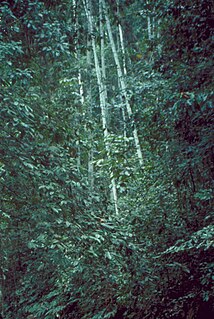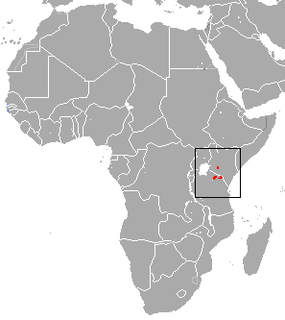
The Amani Nature Reserve is a protected area located within the Muheza and Korogwe Districts in the Tanga Region of Tanzania, in tropical East Africa.

The black and rufous elephant shrew, the black and rufous sengi, or the Zanj elephant shrew is one of the 17 species of elephant shrew found only in Africa. It is native to the lowland montane and dense forests of Kenya and Tanzania. Like other members of the genus Rhynchocyon, it is a relatively large species, with adults averaging about 28 cm (11 in) in length and 450-700 g (1.0-1.5 lb) in weight.
Erythrina schliebenii is a species of legume in the family Fabaceae. It is found only in Tanzania. The species is named for German collector and botanist Hans-Joachim Schlieben.

The spotted ground thrush is a species of bird in the family Turdidae. It is found in the Democratic Republic of the Congo, Kenya, Malawi, South Africa, Sudan, Tanzania, and possibly Mozambique.

The green barbet is a species of bird in the Lybiidae family. It is found in Kenya, Tanzania, Malawi, Mozambique and South Africa. It occurs in forests from sea level to 1,800 metres (5,900 ft). Its isolated populations are vulnerable to forest clearing.

The East African highland shrew is a species of mammal in the family Soricidae. It is found in Kenya and Tanzania. Its natural habitats are subtropical or tropical moist montane forests, subtropical or tropical high-altitude grassland, and swamps.

The Bornean pygmy shrew is a species of shrew in the family Soricidae. It was named for zoologist Charles Hose.

The East African little collared fruit bat is a species of megabat in the family Pteropodidae. It is found in Kenya, Tanzania, and Zimbabwe. Its natural habitats are subtropical or tropical dry forests and moist savanna. It is threatened by habitat loss.

The Aldabra flying fox is a species of megabat in the genus Pteropus. It is endemic to the Aldabra Atoll in the Seychelles, like Chaerephon pusilla, though the latter may be the same species as the little free-tailed bat.

Decken's horseshoe bat is a species of horseshoe bat. It is found in Kenya and Tanzania. Its natural habitats are subtropical or tropical moist lowland forest, subtropical or tropical moist montane forest, moist savanna, caves, and subterranean habitats. It is threatened by habitat loss.

Protea comptonii, also known as saddleback sugarbush, is a smallish tree of the genus Protea in the family Proteaceae. It is found in South Africa and Eswatini.

The wildlife of Zanzibar consists of terrestrial and marine flora and fauna in the archipelago of Zanzibar, an autonomous region of Tanzania. Its floral vegetation is categorized among the coastal forests of eastern Africa as the Southern Zanzibar-Inhambane coastal forest mosaic and the Northern Zanzibar-Inhambane coastal forest mosaic. Its faunal species are mostly small animals, birds, and butterflies.
The Flora of Tropical East Africa (FTEA) is a catalogue of all 12,104 known wild plant species in Uganda, Kenya, and Tanzania. The project began in 1948 and was finally completed in September 2012. Approximately 1,500 new plant species were described, by 135 botanists from 21 countries.
Agelanthus rondensis is a species of hemiparasitic plant in the family Loranthaceae. It is endemic to Tanzania.
Agelanthus kayseri is a species of hemiparasitic plant in the family Loranthaceae, which is native to Kenya, Tanzania and Somalia.
Agelanthus keilii is a species of hemiparasitic plant in the family Loranthaceae, which is native to Rwanda, Tanzania and Burundi.
Agelanthus microphyllus is a species of hemiparasitic plant in the family Loranthaceae, which is native to Ethiopia, Kenya and Tanzania.
Agelanthus uhehensis is a species of hemiparasitic plant in the family Loranthaceae, which is native to Tanzania.
Agelanthus validus is a species of hemiparasitic plant in the family Loranthaceae, which is found in the Usambara Mountains, Tanzania
Agelanthus longipes is a species of hemiparasitic plant in the family Loranthaceae, which is found in the Tanzania, Mozambique and Kenya.











